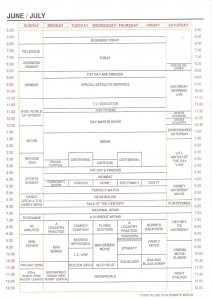 Imparja Television, Australia’s indigenous-owned commercial TV network, is celebrating 25 years of broadcasting this year.
Imparja Television, Australia’s indigenous-owned commercial TV network, is celebrating 25 years of broadcasting this year.
The first transmission — a Test Cricket match between Australia and Sri Lanka — was broadcast on 2 January 1988. The channel was officially opened two weeks later.
For viewers in the central Australian region, including remote towns Alice Springs, Tennant Creek, Katherine, Leigh Creek, Coober Pedy and Ceduna, it was their first taste of commercial television — made possible only by the advent of the domestic satellite Aussat.
Imparja is broadcast via terrestrial transmission in larger remote centres, but the signal was also available to direct-to-home satellite receivers within Imparja’s satellite footprint covering Northern Territory and South Australia.
At the time of its first test broadcast Imparja had an estimated audience of 62,000. This week the network is again broadcasting a Test Cricket match, between the same two teams, to an estimated coverage area of 685,000 viewers in regional and remote areas across all states except Western Australia, via either terrestrial or satellite (VAST) transmission.
Imparja chief executive Alistair Feehan said the network has grown from humble beginnings:
“Starting with a basic one-channel analogue broadcast, Imparja has moved into the digital age and now broadcasts 6 digital channels, including the recent addition of ICTV, which was launched with the assistance of grant funding provided by the Federal Government in 2012. The station upgraded its facilities in 2008, moving into a brand new purpose built $9 million digital station.”
Although Imparja is celebrating 25 years of success in an ever-changing media environment, it wasn’t always smooth sailing. The process for the Central Australian Aboriginal Media Association (CAAMA) to gain the licence to operate a remote commercial television service (RCTS) to central Australia in the mid-1980s was complicated by a competing bid and subsequent appeal to the Federal Court by Television Capricornia, a company associated with Darwin channel NTD8 that had come under the ownership of Kerry Packer. Television Capricornia’s appeal to the Federal Court was dropped at the last minute, allowing CAAMA to launch Imparja, ending a process that took four years.
Initially offering a composite schedule of programming from all three commercial networks plus its own local programs, the advent of competition in 1999 — via the aggregation of Imparja’s coverage area with the Remote Eastern Australia market — saw Imparja adopt a joint Nine and Ten network schedule.
Imparja also provided technical facilities for the transmission of an indigenous community TV service, ICTV, utilising spare channel capacity in the satellite. ICTV was then replaced in 2007 by the new national Indigenous television service NITV. With NITV now part of SBS, ICTV has since returned to the Imparja satellite platform with the assistance of the Federal Government.
These days, Imparja operates an affiliate of the Nine Network and also re-broadcasts Nine’s digital channels GO! and GEM across its coverage area. Imparja is also a joint partner in Central Digital Television, offering a Network Ten signal — including digital channels One and Eleven.
 Imparja still provides some local production with children’s program Yamba’s Playtime as well as commercials for its local clients.
Imparja still provides some local production with children’s program Yamba’s Playtime as well as commercials for its local clients.
Being a not-for-profit venture owned by the Indigenous community, over its 25 years Imparja has contributed back to the community with tens of millions of dollars donated to local communities and groups within its coverage area.
Imparja is scheduled to cease any remaining analogue transmission in December 2013.
Source: Imparja, National Film and Sound Archive
June/July 1989 Program Schedule (click to enlarge):









